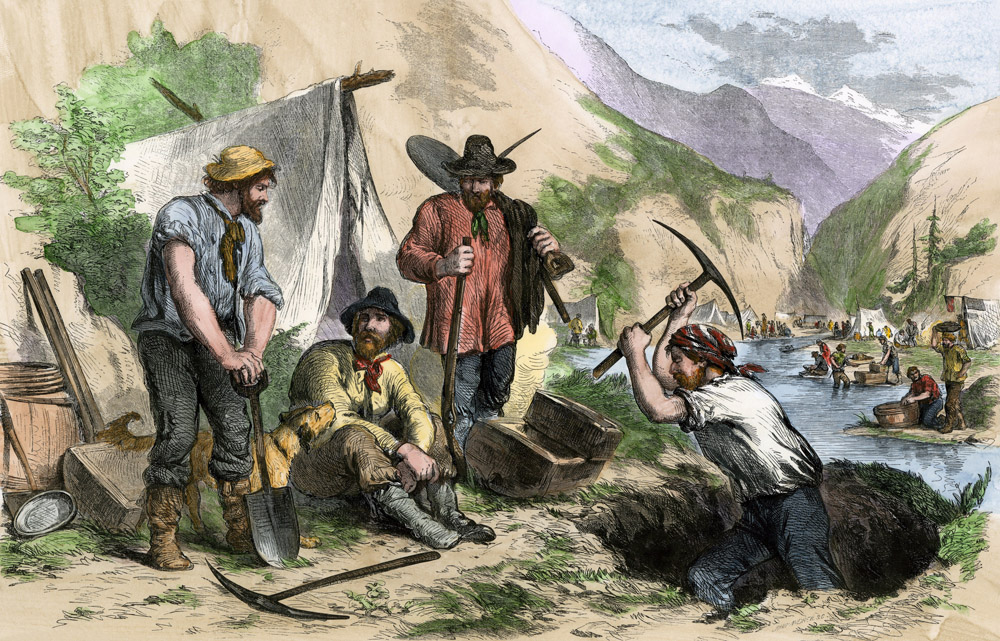The Gold Rush- Terminale- Anglais
- Fiche de cours
- Quiz et exercices
- Vidéos et podcasts
Découvrir l'épisode historique de la Ruée vers l'or.
- La ruée vers l'or en Californie eut lieu de 1848 à 1856. Elle démarra après qu'un charpentier découvrît une pépite dans le lit d'une rivière. On vint même de l'étranger en quête d'or.
- Mais les conditions sont difficiles. Outre les problèmes de santé, la météo rude et les attaques d'Indiens, les chercheurs passent des heures entières les pieds dans l'eau froide à creuser et tamiser.
- En quelques mois, l'or se fait plus dur à trouver et les tensions augmentent d'autant plus que de nouveaux chercheurs ne cessent d'arriver. Certains rentrèrent chez eux bredouilles, d'autres s'organisèrent en entreprises de manière à pouvoir se procurer le matériel devenu nécessaire pour être productif.
- En 8 ans, les filons sont épuisés et les villes créées alors se vident, devenant des villes fantômes.
- Quoiqu'il en soit, cet épisode a façonné la Californie multiculturelle que l'on connait aujourd'hui. Cet État attire toujours les aventuriers (milieu artistique, milieu des affaires).
Although there were many gold rushes in world history, the Californian gold rush was unique. The events that took place in the western part of America between 1848 and 1856 were to have determining consequences on the history and geography of the USA.
On the 24th of
January 1848, James Wilson Marshall, a
carpenter from New Jersey, while building a sawmill for
John Augustus Sutter, saw and picked up gold nuggets from the American
River (near the Sacramento River), near
Coloma.
The word spread like fire. First, only those who were
already in California started digging for gold. On
April, 15th 1848, the word about gold
reached the East coast, but people were sceptical as
there had already been rumours of gold before.
President James K.
Polk confirmed gold
had been found on December 5th, 1848 :
the Gold Rush was on.

|
| Doc. The Gold Rush in California |
From all over the country, and from abroad (Mexico,
China, France, Germany, etc.), adventurers rushed to
the Eldorado. Some walked, some sailed, some rode to
this promise land, putting up with unbearable
conditions (weather, health, Indian attacks, etc.) that
only the hope of finding gold could make them endure.
Most of them « saw the
elephant ».
The gold diggers were called
« Forty Niners »
because they had left home in 1849. That year, it is
estimated that 80,000 Forty Niners went West.
Digging for gold was hard work. The gold diggers spent
back-breaking days in cold water digging, sifting. At
the beginning, gold was easy to find. By mid 1849, as
easy gold became scarce and miners more numerous,
tensions increased. Life was extremely expensive. Many
diggers returned home empty-handed. New technological
advances obliged miners to join or organise large
companies.
Those who really enriched from the Gold Rush were
entrepreneurs, such as Levi Strauss (famous for his
blue jeans), who supplied the gold miners with
much-needed equipment and bare necessities.
Year after year, gold was nowhere to be found: the cities quickly became ghost towns. In 1856, eight years after it had started, the Gold Rush was over.
To finish with, the spirit of adventure has lived on. Nowadays people do not look for gold anymore but for fame and success (in Hollywood, in the Silicon Valley, etc.) California is the place that attracts risk-takers and entrepreneurs and where the American dream is still alive.

Des quiz et exercices pour mieux assimiler sa leçon
La plateforme de soutien scolaire en ligne myMaxicours propose des quiz et exercices en accompagnement de chaque fiche de cours. Les exercices permettent de vérifier si la leçon est bien comprise ou s’il reste encore des notions à revoir.

Des exercices variés pour ne pas s’ennuyer
Les exercices se déclinent sous toutes leurs formes sur myMaxicours ! Selon la matière et la classe étudiées, retrouvez des dictées, des mots à relier ou encore des phrases à compléter, mais aussi des textes à trous et bien d’autres formats !
Dans les classes de primaire, l’accent est mis sur des exercices illustrés très ludiques pour motiver les plus jeunes.

Des quiz pour une évaluation en direct
Les quiz et exercices permettent d’avoir un retour immédiat sur la bonne compréhension du cours. Une fois toutes les réponses communiquées, le résultat s’affiche à l’écran et permet à l’élève de se situer immédiatement.
myMaxicours offre des solutions efficaces de révision grâce aux fiches de cours et aux exercices associés. L’élève se rassure pour le prochain examen en testant ses connaissances au préalable.

Des vidéos et des podcasts pour apprendre différemment
Certains élèves ont une mémoire visuelle quand d’autres ont plutôt une mémoire auditive. myMaxicours s’adapte à tous les enfants et adolescents pour leur proposer un apprentissage serein et efficace.
Découvrez de nombreuses vidéos et podcasts en complément des fiches de cours et des exercices pour une année scolaire au top !

Des podcasts pour les révisions
La plateforme de soutien scolaire en ligne myMaxicours propose des podcasts de révision pour toutes les classes à examen : troisième, première et terminale.
Les ados peuvent écouter les différents cours afin de mieux les mémoriser en préparation de leurs examens. Des fiches de cours de différentes matières sont disponibles en podcasts ainsi qu’une préparation au grand oral avec de nombreux conseils pratiques.

Des vidéos de cours pour comprendre en image
Des vidéos de cours illustrent les notions principales à retenir et complètent les fiches de cours. De quoi réviser sa prochaine évaluation ou son prochain examen en toute confiance !









